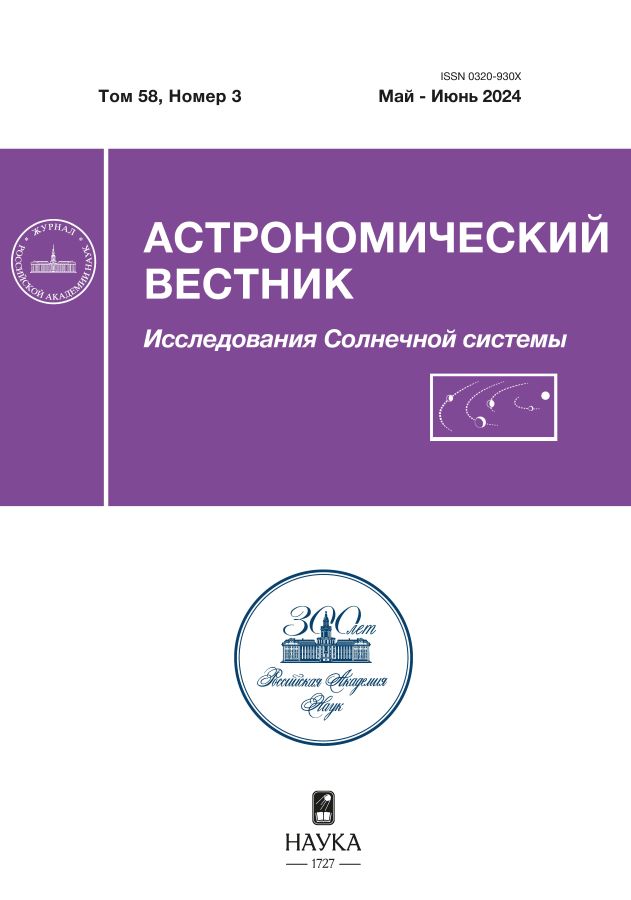О влиянии неустойчивости Рэлея–Тейлора на формирование пылевых облаков в мезосфере Марса
- Authors: Резниченко Ю.С.1,2, Дубинский А.Ю.1, Попель С.И.1
-
Affiliations:
- Институт космических исследований РАН
- Московский физико-технический институт (национальный исследовательский университет)
- Issue: Vol 58, No 3 (2024)
- Pages: 269-275
- Section: Articles
- URL: https://ter-arkhiv.ru/0320-930X/article/view/648510
- DOI: https://doi.org/10.31857/S0320930X24030015
- EDN: https://elibrary.ru/NEGBPG
- ID: 648510
Cite item
Abstract
Представлена теоретическая модель, описывающая режим оседания плазменно-пылевых облаков в мезосфере Марса. Рассчитаны значения характерных размеров пылевых частиц облака, предсказываемые моделью. Показано, что важным фактором, влияющим на процесс формирования плазменно-пылевых структур в марсианской атмосфере, является неустойчивость Рэлея–Тейлора, ограничивающая (сверху) допустимые размеры пылевых частиц облака.
Full Text
About the authors
Ю. С. Резниченко
Институт космических исследований РАН; Московский физико-технический институт (национальный исследовательский университет)
Author for correspondence.
Email: dvju@yandex.ru
Russian Federation, Москва; Долгопрудный
А. Ю. Дубинский
Институт космических исследований РАН
Email: dvju@yandex.ru
Russian Federation, Москва
С. И. Попель
Институт космических исследований РАН
Email: popel@iki.rssi.ru
Russian Federation, Москва
References
- Алтунин В.В. Теплофизические свойства двуокиси углерода. М.: Изд. стандартов, 1975. 546 с.
- Дубинский А.Ю., Попель С.И. Формирование и эволюция плазменно-пылевых структур в ионосфере // Письма в ЖЭТФ. 2012. Т. 96. № 1. С. 22–28.
- Дубинский А.Ю., Резниченко Ю.С., Попель С.И. К вопросу о формировании и эволюции плазменно-пылевых структур в ионосферах Земли и Марса // Физика плазмы. 2019. Т. 45. № 10. C. 913–921.
- Дубинский А.Ю., Резниченко Ю.С., Попель С.И. О кинетических особенностях седиментации пылевых частиц в атмосфере Марса // Астрон. вестн. 2023. Т. 57. № 3. С. 225–231. (Dubinsky A. Yu., ReznichenkoYu.S., Popel S.I. On the kinetic features of sedimentation of dust particles in the Martian atmosphere // Sol. Syst. Res. 2023. V. 57. № 3. P. 214–220).
- Извекова Ю.Н., Попель С.И. Плазменные эффекты в пылевых вихрях у поверхности Марса // Физика плазмы. 2017. Т. 43. № 12. С. 1010–1017.
- Клумов Б.А., Владимиров С.В., Морфилл Г.Е. Особенности пылевых структур в верхней атмосфере Земли // Письма в ЖЭТФ. 2005б. Т. 82. № 10. С. 714–719.
- Клумов Б.А., Морфилл Г.Е., Попель С.И. Формирование структур в запыленной атмосфере // ЖЭТФ. 2005а. Т. 127. № 1. С. 171–185.
- Ландау Л.Д., Лифшиц Е.М. Статистическая физика. Часть 1. М.: Наука, 1976. 584 с.
- Савельев Р.С., Розанов Н.Н., Сочилин Г.Б., Чивилихин С.А. Релей-Тейлоровская неустойчивость запыленного газа // Научно-техн. вестн. Санкт-Петербургского гос. университета информ. технологий, механики и оптики. 2011. Т. 73. № 3. С. 18–22.
- Шематович В.И., Бисикало Д.В., Жилкин А.Г. Влияние вариации протяженной водородной короны Марса на эффективность перезарядки с протонами солнечного ветра // Астрон. журн. 2021. Т. 98. № 3. С. 232–238.
- Barnes M.S., Keller J.H., Forster J.C., O’Neill J.A., Coultas D.K. Transport of dust particles in glow-discharge plasmas // Phys. Rev. Lett. 1992. V. 68. P. 313–316.
- Forget F., Montmessin F., Bertaux J.L., Gonzalez-Galindo F., Lebonnois S., Quemerais E., Reberac A., Dimarellis E., Lopez-Valverde M.A. Density and temperatures of the upper Martian atmosphere measured by stellar occultations with Mars Express SPICAM // J. Geophys. Res. 2009. V. 114. id. E01004 (19 p.).
- Fortov V.E., Ivlev A.V., Khrapak S.A., Khrapak A.G., Morfill G.E. Complex (dusty) plasmas: Current status, open issues, perspectives // Phys. Reports. 2005. V. 421. P. 1–103.
- Fox J.L., Benna M., Mahaffy P.R., Jakosky B.M. Water and water ions in the Martian thermosphere/ionosphere // Geophys. Res. Lett. 2015. V. 42. P. 8977–8985.
- Hayne P.O., Paige D.A., Schofield J.T., Kass D.M., Kleinböhl A., Heavens N.G., McCleese D.J. Carbon dioxide snow clouds on Mars: South polar winter observations by the Mars climate sounder // J. Geophys. Res. 2012. V. 117. id. E08014 (23 p.).
- Klumov B.A., Popel S.I., Bingham R. Dust particle charging and formation of dust structures in the upper atmosphere // JETP Lett. 2000. V. 72. № 7. P. 364–368.
- Montmessin F., Bertaux J.L., Quémerais E., Korablev O., Rannou P., Forget F., Perriera S., Fussend D., Lebonnoisc S., Rébéraca A. Subvisible CO2 ice clouds detected in the mesosphere of Mars // Icarus. 2006. V. 183. P. 403–410.
- Montmessin F., Gondet B., Bibring J.P., Langevin Y., Drossart P., Forget F., Fouchet T. Hyperspectral imaging of convective CO2 ice clouds in the equatorial mesosphere of Mars // J. Geophys. Res. 2007. V. 112. id. E11S90 (14 p.).
- Popel S.I., Kopnin S.I., Yu M.Y., Ma J.X., Huang F. The effect of microscopic charged particulates in space weather // J. Phys. D: Applied Phys. 2011. V. 44. id. 174036.
- Reznichenko Yu.S., Dubinskii A. Yu., Popel S.I. On dusty plasma formation in Martian. ionosphere // J. Phys.: Conf. Ser. 2020. V. 1556. id. 012072 (7 p.).
- Shukla P.K., Mamun A.A. Introduction to Dusty Plasmas Physics. Bristol/Philadelphia: Inst. Phys. Publ., 2002. 270 p.
- Tsytovich V.N., Morfill G.E., Vladimirov S.V., Thomas H. Elementary Physics of Complex Plasmas. Berlin/Heidelberg: Springer, 2008. 370 p.
- Zahn U., Baumgarten G., Berger U., Fiedler J., Hartogh P. Noctilucent clouds and the mesospheric water vapour: the past decade // Atmos. Chem. Phys. 2004. V. 4. P. 2449–2464.
- Whiteway J.A., Komguem L., Dickinson C., Cook C., Illnicki M., Seabrook J., Popovici V., Duck T.J., Davy R., Taylor P.A., Pathak J., Fisher D., Carswell A.I., Daly M., Hipkin V., Zent A.P., Hecht M.H., Wood S.E., Tamppari L.K., Renno N., Moores J.E., Lemmon M.T., Daerden F., Smith P. Mars water-ice clouds and precipitation // Science. 2009. V. 325. Iss. 5936. P. 68–70. https://www.newsru.com/hitech/30may2021/mars_ clouds.html
Supplementary files













